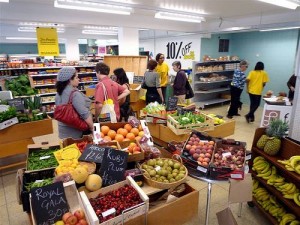- Figure 1: The People’s Supermarket (What’s on in London, 2013).
Long gone are the days of the prominent Corner shop and local Supermarket, the super chains are now the big winners. On one small stretch of suburban shops in Sheffield lie a Eurospar, Tesco, Costa Coffee, Starbucks and Sainsbury’s. What once was an area with individual shops is slowly but surely being commercialised and transformed into a mini city centre itself. With technological advances in transport and logistics, aided through the internet explicitly, companies can afford to import goods from afar without reflecting on their carbon footprint, something which shouldn’t be dismissed so easily!
With the aim of producing fair prices of quality food to both producers and consumers, restaurant owner Arthur Potts Dawson established The People’s Supermarket, (2013) in Holborn, London May 2010. The project was documented by Channel 4 as part of a mini-series reaffirming the local whilst retaining sustainable supplier linkages with the community volunteering at the shop – a positive example of technology. British supermarkets bin over 1,000 tonnes of food a day; Arthur’s aim was to create a zero-waste supermarket, ‘for the people by the people.’ This concept is heavily based on the renowned Park Slope Food Co-op (PSFC) in Brooklyn, New York. Founded in 1973 it now has over 15,500 members.
Since 2004, the PSFC have been actively involved in sustainability boycotts including Coca-Cola products, Minute Maid and Odwalla; quoting the company’s labour practices and exploitation of natural resources in third-world countries. In 2008, the PSFC General Meeting resolved that the co-op would discontinue selling bottled water and stop providing plastic shopping bags at checkout.
An article by Ilbery and Maye (2005) focusing on food supply chains and sustainability emphasises the importance of correctly sourced local resources. It also acknowledges that the EU is encouraging the local food sector via the introduction of the Rural Development Regulation. The New Economic Foundation showed that for every £1 spent at a local organic box scheme £2.59 was generated for the local economy compared with £1.40 generated by every £1 spent at a supermarket (Boyde, 2001; see also Sacks, 2002).
We must be careful in identifying sustainable foods as the origin of a Short Food Supply Chain (SFSC) is not necessarily the point of production, but a series of upstream suppliers as found in regular food chains. SFSCs can still sometimes involve considerable distances, causing controversy over food miles and economic leakage. Ilbery and Maye (2005) support the works of public procurement of cooperatives stating its potential for greater economic, social and environmental sustainability and broadening awareness. They stress however that reconnection between food producers and consumers won’t progress through the development of speciality and niche market food products alone. Perhaps technology can help us promote sustainable food consumption and these individual markets, like that of the very successful 100 Mile-Diet. An experiment conducted by Alisa Smith and J.B. MacKinnon in 2005 for a year has inspired 1000s and continues to do so through their website, encouraging the sharing of stories and local foods knowledge (100 Mile-Diet, 2006). With greater awareness through technology such as the internet, perhaps people will begin to question the true origins of their food and its’ repercussions towards the local sustainable supermarket.
References
Boyde, T., (2001) Cusgarne Organics Local Money Flows. New Economics Foundation, London.
Ilbery, M. and Maye, D. (2005) Food supply chains and sustainability: evidence from specialist food producers in the Scottish/English borders. Land Use Policy. 22:331-344.
Park Slope Food Co-op (1973) http://foodcoop.com (accessed 4th March 2013).
The People’s Supermarket (2013) http://www.thepeoplessupermarket.org (accessed 4th March 2013).
Sacks, J., (2002) The Money Trail: Measuring your Impact on the Local Economy Using LM3. New Economics Foundation, London.
What’s on in London (2013) http://www.whatsoninlondon.co.uk/attraction/the-peoples-supermarket/ (accessed 4th May 2013).
100 Mile-Diet (2006) http://localdiet.org (accessed 25th April 2013).

